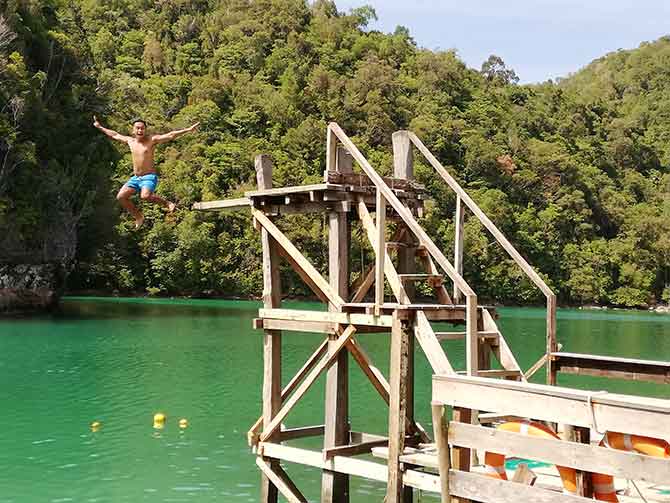
In 2018, more than seven million tourists visited Siargao.
Those who have not been to Siargao or heard of it may go for a mad scramble to Google it and wonder why such a huge horde of people will visit this dot of an island in the southeast extremities of the Philippines.
Well for one, it is a surfers’ haven. Surfers and surfing enthusiasts from all over the world converge on the island from the months of April to October. And, for non-surfers like me, the island is a treasure trove of natural wonders difficult to find anywhere else.
But before I go into that. let me get you up to speed about this island that merits about 3 million searches a day.
What and Where is Siargao
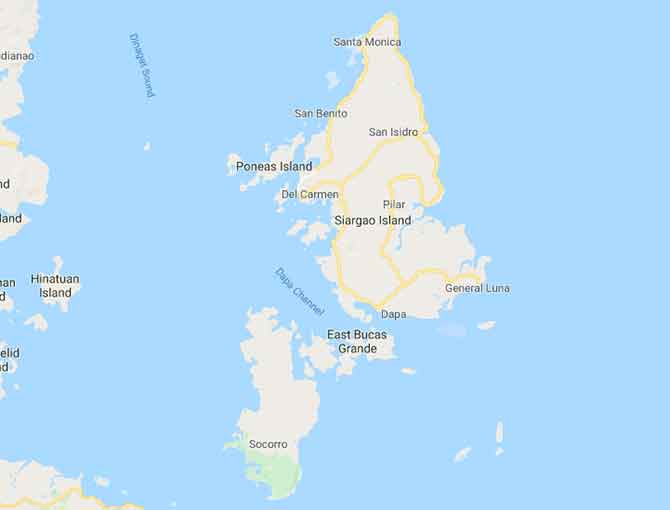
Siargao is a teardrop-shaped island in Southern Philippines. It belongs to the CARAGA region. Caraga, in early chronicles, means the Land of Brave People and Fierce People. But there is nothing fierce about the region comprising of Agusan del Norte and del Sur, Dinagat Islands, Surigao del Norte, and del Sur. Its capital, Surigao City, is 62 kms to the west of the island. Connecting the two is a ferry boat ride that can take an hour-and-a-half.
Surigao City – Siargao Ferry Boat Service
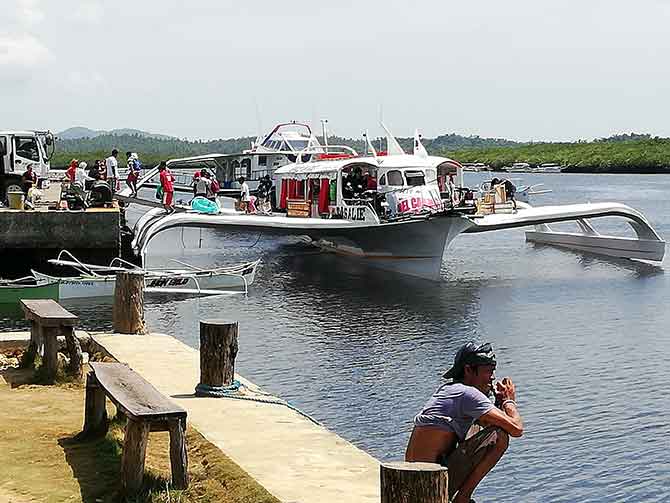
On the contrary, the Surigaonons are friendly and nice people. Communicating with them is no problem. Depending on who they are talking to, they can manage English, Pilipino (the country’s national language), or Cebuano – the dialect heavily used in Central Philippines.
On average, 10 flights (PAL and Cebu Pacific) land in Siargao each day. They come from any of the country’s three international airports, namely Clark, Manila, and Cebu, and they land at Sayak Domestic Airport in Del Carmen, Siargao.
Flying time from Manila, the country’s capital, is about 2 hrs and 40 mins, while that from Cebu is an hour. Each flight carries a sprinkling of residents and a horde of tourists, both local and foreign. From there, hired vans or tricycles (motor-driven cab) can take them anywhere on the island.
By “anywhere,” I mean Gen. Luna – the ultimate destination of all visitors. In fact, when people talk of Siargao, what is really meant is this small town at the southern tip of the island.
Gen. Luna, Siargao
Siargao has jurisdiction over 48 islands and nine towns. Gen. Luna is one of these towns, and responsible for its placement on the map.
Gen. Luna is a 45-min to an hour’s drive from the airport. Along the way, you will be afforded a glimpse of some Siargao towns. They all have different names but share one thing in common – they are rural and under-developed. Sans the modern-day vehicles and ubiquitous telecommunications towers, they could very well be the Sleepy Hollow of the Philippines.
Except for Gen. Luna.
What makes it stand out over the rest is the long stretch of a two-lane concrete road running parallel to the coast – the Surfers’ Row (I coined this because the town has no street names or house numbers).
Surfers’ Row, Gen. Luna
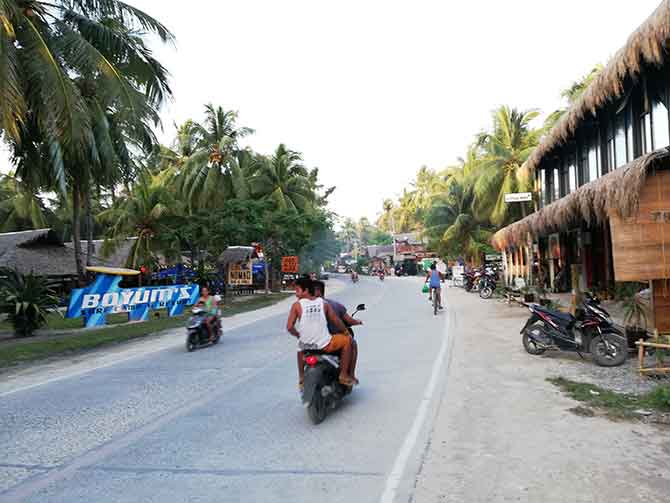
Surfers’ Row is like a modern-day version of an old and dusty mining town in the Wild, Wild West era – a one-street affair with cheap-looking restaurants, bars, and hotels on both sides of the road. Except that nothing is cheap in Gen. Luna, especially food. Compared to Puerto Princesa in Palawan with much better tourism infrastructure, the cost-of-stay in Siargao is nothing short of hi-way robbery.
Typical street scene, Surfers’ Row
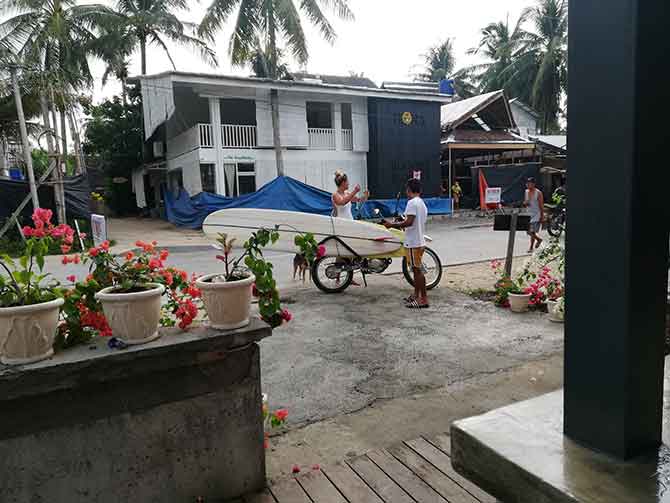
And that’s because of Cloud 9.
Siargao’s Cloud 9
Cloud 9 is at the northeast corner of Gen. Luna. It is almost at the end of Surfers’ row and the place where beach-bummers from all over the world converge to show their mettle.
As an adjective, it is defined “a feeling of well-being or elation.”
Cloud 9 Observation Deck
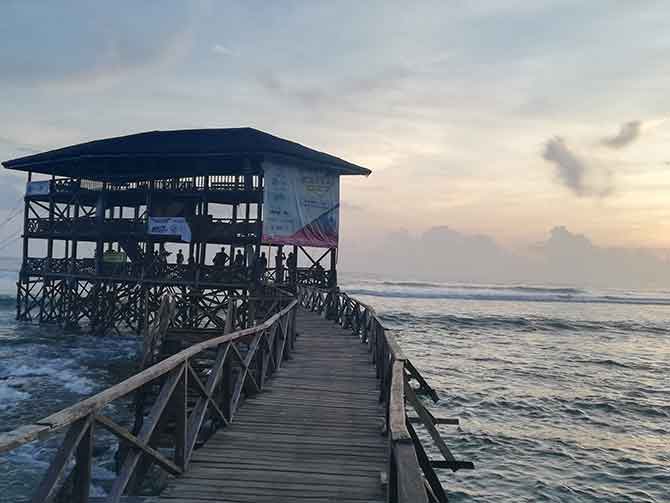
To a surfer, Cloud 9 is that kind of wave that gives the highest feeling of well-being or elation. It is a surfer’s quest – the wave to ride, to conquer.
They come, majestically, one after the other from the wombs of the great Pacific Ocean. From a distance, they look like nothing more than a swell, building in size and force as they near the shore. Then they start to break, forming a froth at its crest before they rumble towards the shore where they break with a roar.
A Cloud 9 surfer looking for his perfect wave
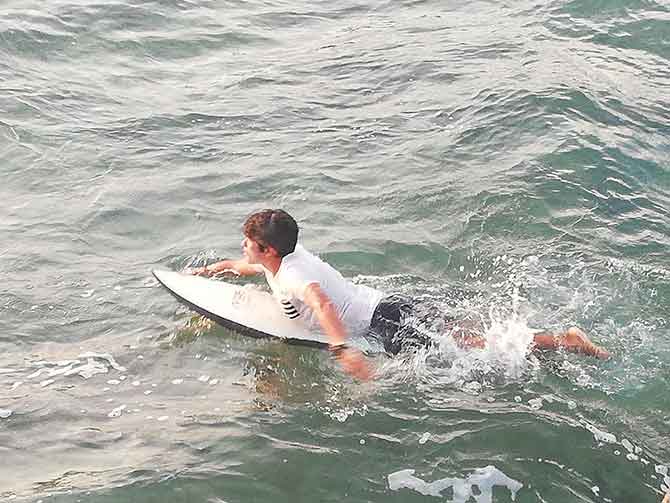
Watching this endless cycle of wave forming, growing and breaking are mesmerizing to a non-surfer. To surfers Tony Arruza and Steve Jones who came in 1980 looking for the “perfect wave,” it was a Eureka moment. They have found their Holy Grail of waves. They called it the Jacking Horse (how it got its present-day name is a mystery).
But it did not hit the big time until 1992 when John Callahan, a famous surfing photographer took pictures of famous surfers John Slater, Taylor Knox, and Kevin Davidson riding huge waves of Cloud 9 and published them in a well-subscribed magazine.
Since then, an international surfing event is held in Gen. Luna each year. This year was held last Oct. 9 and was won by Philmar Alipayo, a local surfer (see video).
For a surfer, the tale and stories of Cloud 9, and Siargao will never end. For those who don’t, the story ends there. And in a sense, the story is a dud; Siargao is overrated.
Fortunately, Siargao has a lot more to offer than surfing. But you have to venture out of Gen. Luna by taking a tour offered by any tour agency near you.
How to enjoy Siargao if you are not a surfer
Siargao was on my bucket list. For a while, I thought it shall remain there. Lately, it became a wish-come-true. My initial impression, however, was very disappointing. After an impressive stay in Puerto Princesa, Palawan, Siargao is a rut. It is backward, dirty and expensive.
Until I joined two tours that covered the following places. They put me on Cloud 9.
Sugba Lagoon
Sugba Lagoon is in Caub Island, 4.5 kms from Poneas Island (see map). Going there takes about 35 mins by motorized outrigger boats from Del Carmen. The route is dotted with numerous islands, lushly covered with mangroves, and is so scenic to keep your senses alive.
Then before you know it, and through a small inlet impossible to see from a distance, you are there.
And behold. To say the place is mesmerizing is an understatement. It’s kind of being transported into another world – a world, a world fantasy, and fairy tales.
Sugba Lagoon scenes
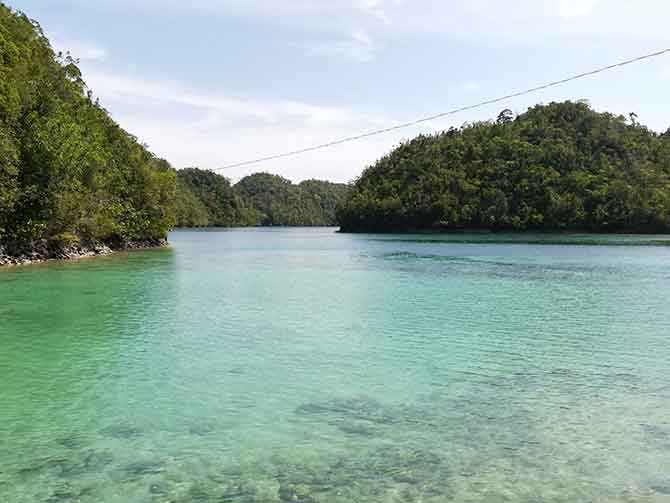
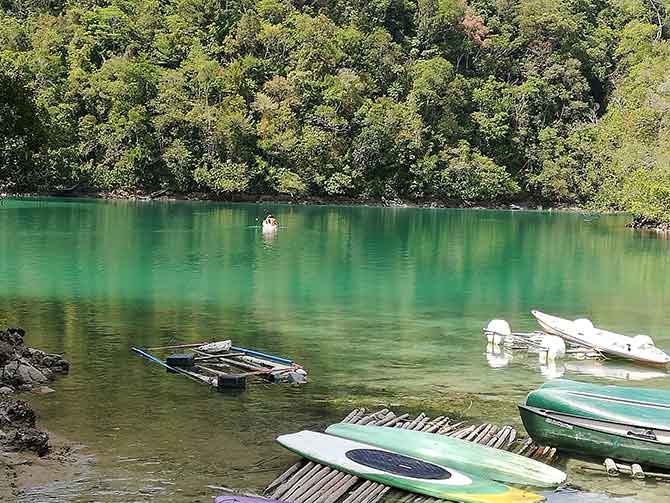
Sugba Lagoon is unbelievably breathtaking. It’s placed emerald green waters make a soothing contrast against the thick vegetation that surrounds the place. The water is so clear you can see the bottom and is free of that scourge of humankind – trash.
I am a sea-lover and the waters of Sugba Lagoon stirred in a deep desire for a reunion. So I took a short swim.
Bukas Grande
Equally enchanting, albeit more stunning, is Sohoton Cove. It is a National Park and is located at Bukas Grande – a group of small islands within the jurisdiction of Socorro.
Getting there is not for people with a severe case of sea-sickness. But if you brave it, the two-hour boat ride is worth the ordeal.
It was for me – upon seeing it I was transfixed like a statue and was gripped with a sudden rush of emotion I was not able to say anything but, “Wow.”
Bukas Grande reception cottage
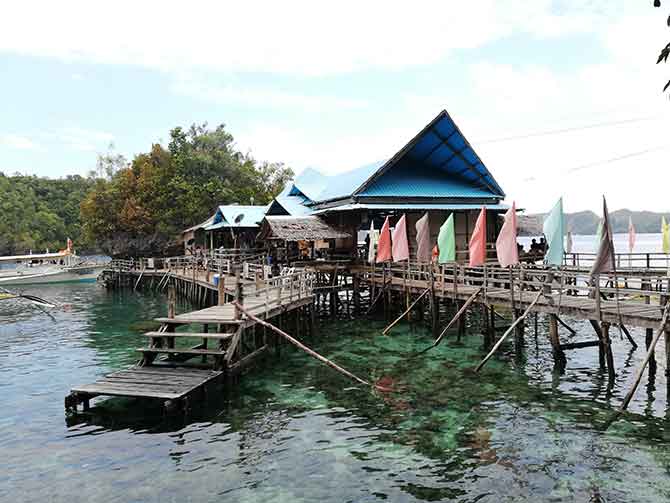
On its own, Bukas Grande can stand toe-to-toe against the world’s best natural wonders. But its magic is not of itself alone, but of these two breathtaking sites within its bosom:
Sohoton Cove
Sohoton Cove is a challenge. It is inaccessible during high tide and getting inside is a touch-and-go when the tide is low.
The entrance is through an inlet wide enough for the boat to squeeze through and the ceiling is so low you have to bend to avoid getting an ugly bump on the head.
Entrance, Sohoton Cove
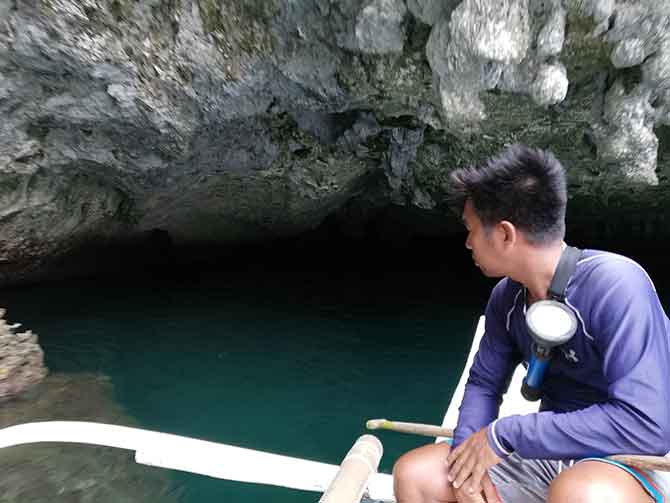
But inside is a totally different world – a world of stunning beauty.
Seven small islets, all covered in lush vegetation, placidly sitting on clear, clean and tranquil waters. It’s so peaceful and quiet, except for the merrymaking of outsiders like me.
Inside Sohoton Cove
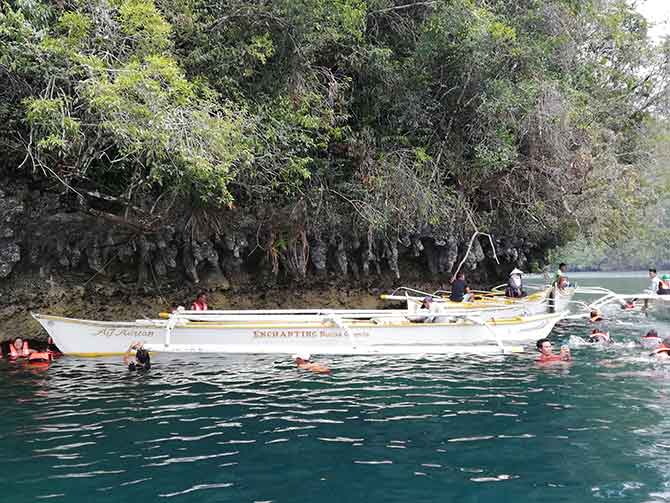
To cater to tourists’ adrenaline rush, a diving platform is built about 20 feet up a cliff. The challenge is in getting there – it is through a small inlet to get to the footpath that perilously winds up to the platform. Once there, you only have one choice – to jump – because going back is more difficult than going up.
Jellyfish Sanctuary
Inclose proximity to the Sohoton Cove is the Tojomon Lagoon – the jellyfish sanctuary.
The locals can’t explain why this species of jellyfish (Mastigias Papua) congregate in that area of Bukas Grande, but the tourism authority knows how to turn them into a tourist attraction.
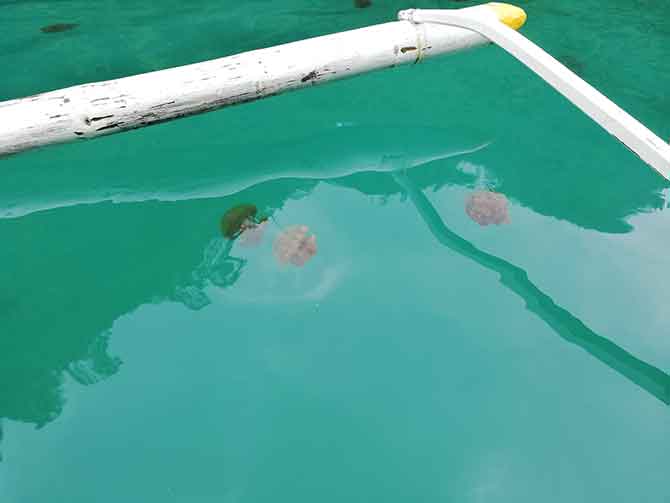
It is so fascinating to see so many small brown critters undulating beneath the surface unmindful of the so many pairs of eyes looking curiously at them.
Contrary to other scary types, the jellyfish in Bukas Grande are harmless. You can swim with them, and touch them. But taking them out of the water is tantamount to murder – you may be fined if you caused the death of one.
The 3-Islands Tour
When the Earth’s crust was undergoing violent upheavals eons ago, strings of magma escaped to the surface. The sea nymphs must have been in a jovial mood at that time, they shaped some into things to suit their playful mood when these escapees colled down and formed islands.
This playfulness can be seen on these islands:
Naked Island
Naked Island is, well, naked. It is nothing but a white sand bar jutting out of the Philippine Sea. Nothing grows on it. Even hardy coconut trees will grow no more than a foot-high sapling then die.
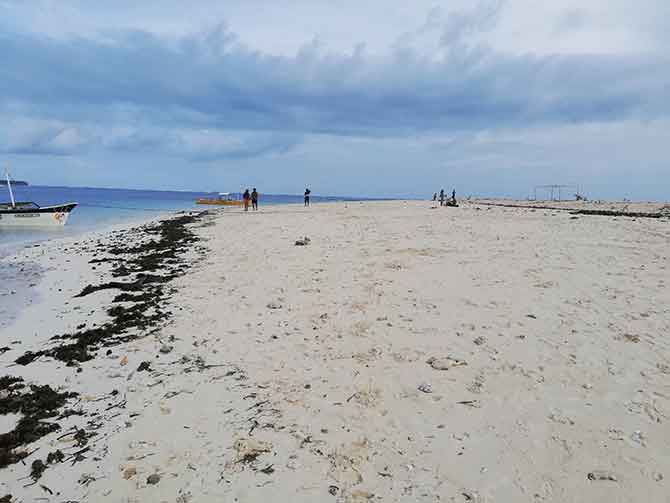
On dark stormy nights, with thunder and lightning making a good light-and-sound background, Naked Island is where sea nymphs build sandcastles or sculpt sand figures of sea gods.
On the more serious side, Naken Island is not typical to Siargao. A similar island can be found in Camiguin Island. But that in Camiguin is not reported to move and change shape as Naked Island do, depending on tidal and wind conditions – so said our boatman.
Daku (Big) Island
Not far from this “sandlot of the gods,” is Daku Island.
Big and flat like a huge dining table, the sea nymphs must have intended Daku to be banquet venue of the sea gods.
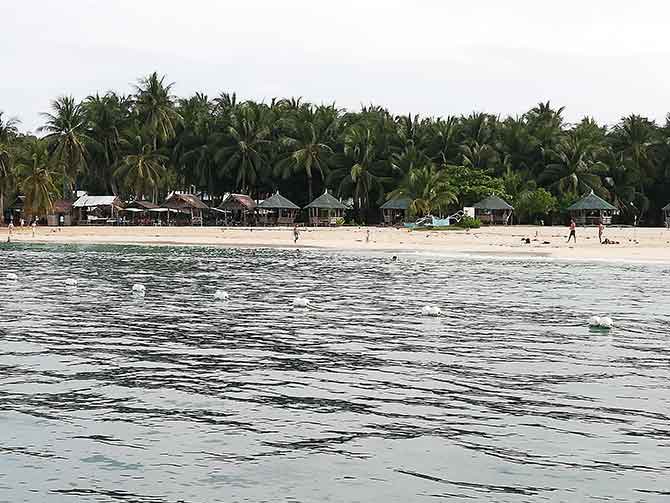
It has an elementary school for the locals and a resort for tourists. It also has a long and wide sandy beach for sand games like volleyball or tug-o-war.
Guyam Island
Roughly 10 mins away by boat, is Guyam Island.
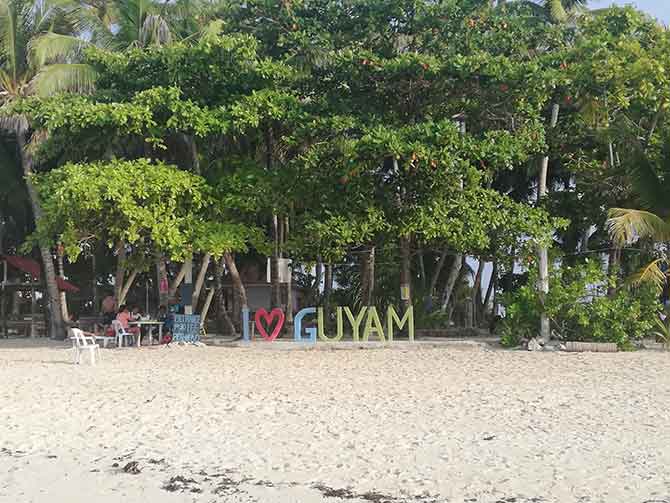
From afar, Guyam looks like a giant cupcake – a fitting dessert for the kingly banquet at Daku.
Guyam is small, and a quarter of its periphery is rocky and constantly battered by huge waves from the Philippines. There is no resort on Guyam but on its southwest side, there’s a cute little beach that attracts small crowds like honeymooners and lovers seeking a more quiet place to enjoy the sea, sand and lots of togetherness.
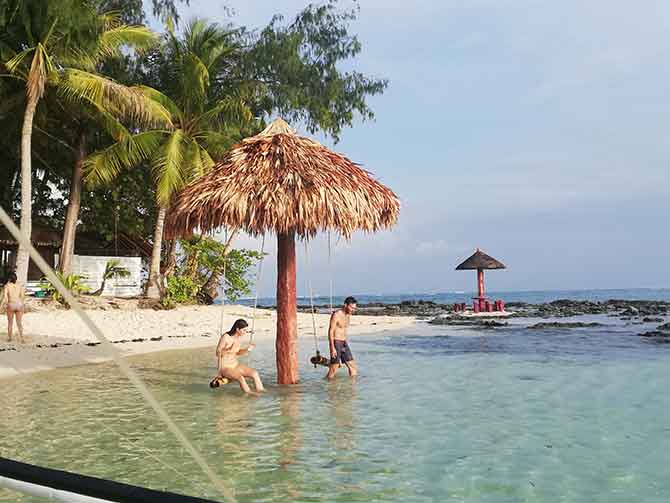
The group started winding its way back to the main island of Siargao when the sun was beginning to cast longer shadows and darkness started creeping on the eastern skies. We were all silent, rapt in our thoughts.
While fatigue was taking over my entire body, my mind was held in disbelief for having just seen and experienced some stunning sites that will soon become pleasant parts of our memories.
You will feel the same way after having gone through these Edenic parts of the country.
~oOo~